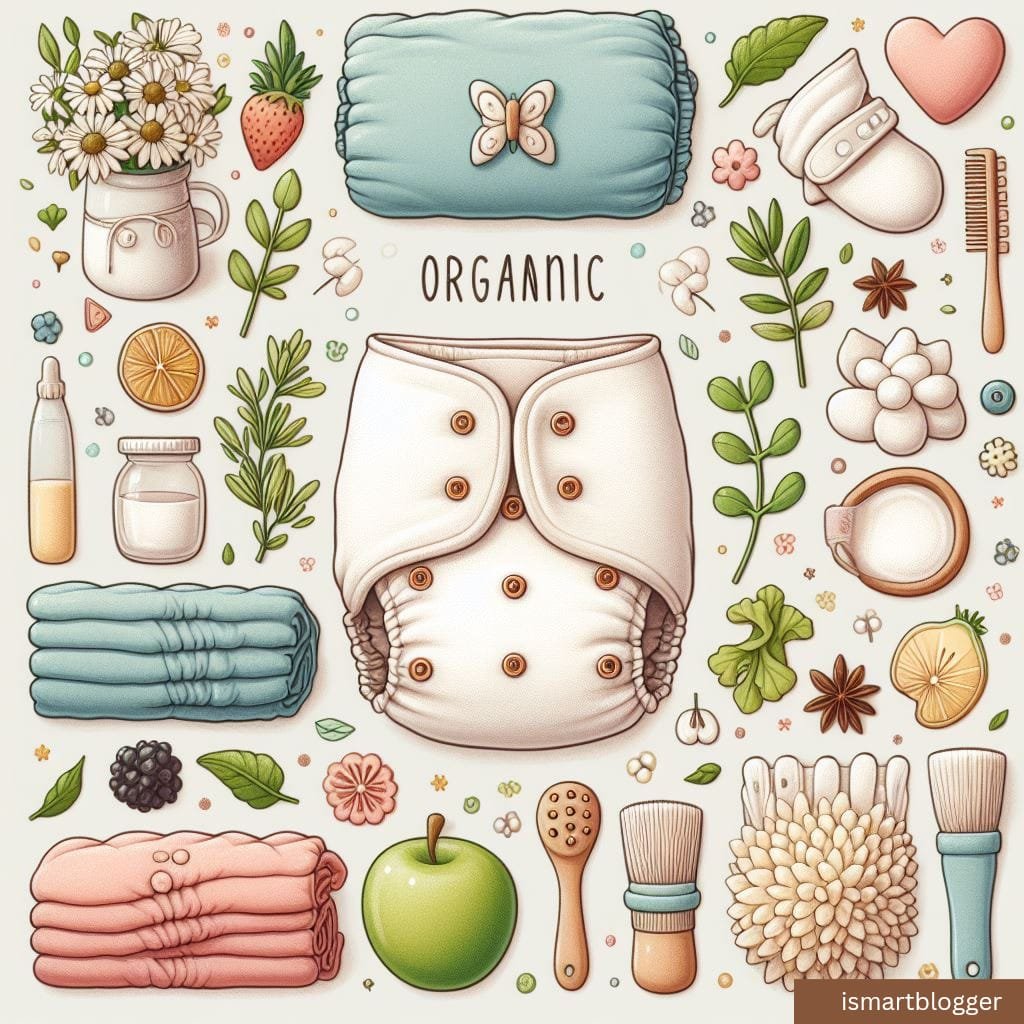Introduction
Organic cloth diapers have gained significant attention and popularity in recent years, as more and more parents seek environmentally friendly and healthier alternatives to traditional disposable diapers. These cloth diapers are made from natural materials, free from harmful chemicals, and are designed for repeated use. In this comprehensive article, we will delve into the fascinating world of organic cloth diapers and explore their numerous benefits for both the environment and babies’ well-being.
Definition and Benefits of Organic Cloth Diapers
Organic cloth diapers are reusable diapering options that are crafted from natural fibers such as organic cotton, hemp, or bamboo. Unlike their disposable counterparts, these diapers can be washed and reused multiple times.
This not only helps reduce waste but also minimizes the carbon footprint associated with diapering. One of the distinctive advantages of organic cloth diapers is their positive impact on the environment.
Disposable diapers contribute heavily to landfill waste. On average, a single baby may require around 6,000 diaper changes until they’re potty-trained, resulting in an enormous amount of non-biodegradable waste that takes hundreds of years to decompose fully.
By choosing organic cloth diapers instead, parents can significantly reduce this environmental burden. Moreover, organic cloth diapers offer considerable health benefits for babies compared to disposables.
Traditional disposable diapers often contain chlorine bleach residues, dioxins, phthalates, fragrance chemicals (linked to allergies), and other potentially harmful substances that may come into direct contact with infants’ delicate skin. In contrast, organic cloth diapers are made from natural fibers without any synthetic additives or toxic substances commonly found in disposables.

Growing Popularity of Using Organic Cloth Diapers
In recent years, there has been a remarkable surge in the popularity of using organic cloth diapers among eco-conscious parents worldwide. This trend can be attributed to several factors:
Firstly, a growing awareness of sustainability issues and environmental concerns has prompted many parents to seek alternative diapering solutions. With increasing emphasis on reducing waste and carbon emissions, organic cloth diapers have emerged as a practical choice that aligns with these values.
Secondly, the desire for chemical-free products has played a significant role in the widespread adoption of organic cloth diapers. Parents are becoming more conscious of the potential health risks associated with exposing their babies to chemicals found in disposable diapers.
Organic cloth diapers provide a safe and natural alternative, eliminating concerns about harmful substances in contact with their baby’s delicate skin. Advancements in design and functionality have made modern organic cloth diapers more user-friendly than ever before.
Gone are the days of complicated folding techniques and cumbersome fasteners; today’s organic cloth diapers come in various styles like p, fitted, pockets, or all-in-ones (AIOs), offering convenience without compromising on environmental or health benefits. The remarkable rise in popularity of using organic cloth diapers can be attributed to their numerous advantages for both the environment and infant well-being.
These reusable, chemical-free alternatives offer parents a sustainable diapering option that reduces waste generation while ensuring their baby’s safety and comfort. In the subsequent sections of this article, we will explore different types of organic cloth diapers available in the market along with their materials and benefits.
Overview of Organic Cloth Diapers
Types of organic cloth diapers:
When it comes to organic cloth diapers, there are several types available in the market. Each type offers its own set of features and benefits. Prefold diapers are one of the most traditional options.
They consist of a rectangular piece of fabric divided into three sections, with the middle section being the most absorbent. Prefolds require folding and fastening with diaper pins or n before placing a waterproof cover over them.
Fitted diapers are contoured to fit the baby’s body, providing a snug and secure fit. They often have multiple layers for enhanced absorbency, and they come with either snaps or h closures for easy fastening.
These diapers usually require a waterproof cover. Pocket diapers are designed with an outer shell that has a pocket opening on one end where you can insert an absorbent insert or “stuff” it inside.
The advantage of pocket diapers is that they allow you to customize the absorbency by adding more inserts as needed. They also feature convenient closures such as snaps or h and loop.
All-in-one (AIO) diapers are considered one of the most convenient options because they include both an absorbent inner layer and a waterproof outer layer sewn together. They resemble disposable diapers in their ease of use since you can simply put them on your baby without any extra steps like stuffing or folding.
Materials used in organic cloth diapers:
Organic cloth diapers prioritize using natural and sustainable materials for both environmental reasons and to ensure they are safe for babies’ delicate skin. Organic cotton is one common material used in manufacturing organic cloth diapers due to its softness, breathability, and high absorbency properties. It is grown without pesticides or synthetic fertilizers, reducing potential exposure to harmful chemicals.
Hemp is another popular material known for its exceptional absorbency. Hemp fabric is antimicrobial, durable, and can hold a large amount of liquid, making it ideal for overnight use.
Hemp is also a highly sustainable crop that requires minimal water and no pesticides during cultivation. Bamboo is a renewable resource that offers excellent absorbency and natural antibacterial properties, making it a popular choice for organic cloth diapers.
Bamboo fabric is incredibly soft and gentle against the baby’s skin, perfect for preventing diaper rash. Overall, these materials not only provide comfort and protection to your little one but also contribute to a more sustainable diapering option compared to disposable alternatives.
Benefits of Using Organic Cloth Diapers
Environmental Benefits: Reduced Waste Compared to Disposable Diapers
Using organic cloth diapers offers significant environmental benefits, particularly in terms of waste reduction. Disposable diapers contribute immensely to landfill waste.
It is estimated that a single baby can generate approximately 3,800 disposable diapers within their first two years alone. These disposable diapers take hundreds of years to decompose, thus burdening our already overwhelmed landfills.
On the other hand, organic cloth diapers are reusable and can be used for multiple children or even repurposed as cleaning cloths once they have served their diapering purpose. This utilization significantly reduces the amount of waste generated and contributes positively towards a sustainable future.
Additionally, the production and disposal of disposable diapers have a considerable carbon footprint due to the resources and energy consumed throughout their lifecycle. The manufacturing process involves the extraction of raw materials like wood pulp and petroleum-based plastic, both contributing to deforestation and environmental degradation.
Moreover, the transportation required for distributing disposable diapers globally adds to greenhouse gas emissions. By using organic cloth diapers, parents play an active role in reducing their carbon footprint by eliminating these harmful effects associated with disposable diaper production.
Health Benefits for Babies: Reduced Risk of Diaper Rash and Skin Irritations
When it comes to the health benefits for babies, using organic cloth diapers proves advantageous in minimizing common issues such as diaper rash and skin irritations often associated with disposable diaper use. Organic cloth diapers are typically made from natural materials like organic cotton or hemp that are gentle on delicate baby skin.
They allow better air circulation around the baby’s bottom compared to non-breathable plastic found in disposables, reducing moisture buildup that can lead to rashes. Furthermore, many disposable diapers contain chemicals such as chlorine, fragrances, dyes, and phthalates that may cause allergic reactions or irritation on a baby’s sensitive skin.
Organic cloth diapers, on the other hand, are free from these harmful substances as they are made from natural fibers without the addition of potentially irritating chemicals. Thus, parents who opt for organic cloth diapers provide a healthier and more comfortable diapering experience for their little ones.
Health Benefits for Babies: No Exposure to Harmful Chemicals Found in Disposable Diapers
Another significant health benefit of using organic cloth diapers is that they eliminate exposure to harmful chemicals present in disposable diapers. Many disposable diaper brands use synthetic materials treated with chlorine during production, leaving traces of dioxin—a known carcinogen—in the final product.
Additionally, some disposable diapers also contain volatile organic compounds (VOCs), which can be released as gases and potentially contribute to indoor air pollution. By choosing organic cloth diapers, parents can rest assured that their babies are not exposed to these harmful substances.
Organic cloth diapers are made from natural materials without the need for chemical treatments or additives. This ensures that babies’ delicate skin remains free from unnecessary exposure to toxins and potentially dangerous compounds found in disposable diapers.
Opting for organic cloth diapers offers both environmental and health benefits. They significantly reduce waste compared to disposable options and have a lower carbon footprint due to their reusable nature.
Furthermore, babies using organic cloth diapers experience a reduced risk of diaper rash and skin irritations while being protected from harmful chemicals commonly found in disposable alternatives. By making this conscious choice, parents prioritize sustainability while providing a safer and healthier diapering experience for their little ones.
Organic Cloth Diaper Accessories
Diaper Covers
Diaper covers are an essential accessory for organic cloth diapers, as they provide an extra layer of protection against leaks and help maintain the overall integrity of the diaper. There are various types of diaper covers available in the market, each with its unique benefits and features.
1. Wool Covers: Wool covers are known for their excellent breathability and natural moisture-wicking properties.
Made from soft, sustainable wool fibers, these covers create a breathable barrier that keeps your baby’s skin dry while allowing airflow. Wool covers also have natural antibacterial properties that help prevent odors and can be used overnight due to their high absorbency.
2. PUL Covers: PUL (Polyurethane Laminate) covers are a popular choice due to their excellent waterproofing capabilities.
These covers feature a layer of polyurethane laminate fabric bonded to either side of a fabric layer, which creates a durable and waterproof barrier. PUL covers come in various cute prints and patterns, making diaper changing time more fun while ensuring leaks stay contained.
3. Fleece Covers: Fleece diaper covers are made from soft polyester fleece material that is water-resistant yet breathable.
They provide a comfortable fit around your baby’s waist and thighs without leaving any marks or causing discomfort. Fleece covers are particularly useful for preventing leaks during daytime use and can be easily washed/dried, making them convenient for busy parents.
Inserts and Boosters
Inserts and boosters play a crucial role in enhancing the absorbency of organic cloth diapers, allowing them to meet the needs of heavy wetters or during overnight use. Different materials offer varying levels of absorbency, each with its advantages.
1. Microfiber Inserts: Microfiber inserts are made from synthetic fibers that have excellent absorption properties.
These inserts are highly affordable and can retain a significant amount of liquid quickly. However, they tend to be bulkier and may lose absorbency over time if not properly cared for, making them more suitable for shorter periods of use.
2. Hemp Inserts: Hemp inserts are an excellent choice for parents looking for a natural and highly absorbent option.
Hemp fibers can hold a substantial amount of liquid while remaining thin, making them ideal for overnight use or heavy wetters. Additionally, hemp has antimicrobial properties, reducing the chance of odor formation.
3. Bamboo Charcoal Inserts: Bamboo charcoal inserts are known for their exceptional absorbency and ability to control odors.
The bamboo charcoal material is highly porous, allowing it to trap moisture effectively while neutralizing any unpleasant smells. Bamboo charcoal inserts are also naturally antibacterial and hypoallergenic, making them gentle on sensitive skin.
When choosing between different insert types, it is essential to consider your baby’s individual needs in terms of absorption levels required and sensitivity to certain materials. Some parents may prefer the convenience of microfiber inserts during daytime use, while others opt for the superior absorbency offered by hemp or bamboo charcoal inserts during nighttime or prolonged periods between changes.
Care and Maintenance of Organic Cloth Diapers
Washing Routine: Prepping, Washing Methods, Detergent Options
Proper care and maintenance are crucial to ensure the longevity and effectiveness of organic cloth diapers. Before using new cloth diapers, it is essential to prep them to enhance their absorbency.
This typically involves washing them multiple times before first use. Check the manufacturer’s instructions for specific prepping requirements.
When it comes to washing organic cloth diapers, several methods can be effective. Many parents opt for a regular machine wash using a gentle cycle with warm water.
However, it is vital to avoid using fabric softeners or excessive amounts of detergent as they can affect the absorbency of the diapers. Instead, choose a mild detergent that is specifically designed for cloth diapers, or look for detergents without added fragrances or dyes.
Stain Removal Techniques: Sunning, Natural Stain Removers
Despite proper care, occasional staining on cloth diapers can occur. To remove stains effectively without compromising the fabric’s integrity, consider harnessing the natural power of sunlight through a technique called sunning.
Simply lay cloth diapers in direct sunlight until they dry naturally – this process helps fade stains remarkably well. Alternatively, there are various natural stain removers available that can be used in combination with regular washing routines.
Oxygen bleach is gentle yet effective for eliminating stubborn stains from organic cloth diapers without causing damage or leaving behind residue. Additionally, lemon juice mixed with baking soda can act as an excellent homemade stain remover when applied directly onto the affected areas before washing.
Storage Tips: Dry Pail vs Wet Pail Method
Proper storage plays a vital role in maintaining clean and odor-free organic cloth diapers between washes. There are two common methods: the dry pail method and the wet pail method. The dry pail method involves storing soiled diapers in a designated diaper pail with a secure lid, without any added liquid.
This method is relatively easy and convenient, especially when combined with the use of diaper liners that can be disposed of before laundering. On the other hand, the wet pail method involves storing soiled diapers in water until they are ready for washing.
However, it is important to note that this method requires extra caution and should be avoided if there are young children or pets around due to drowning hazards. If choosing the wet pail method, it is recommended to use a diaper pail specifically designed for soaking diapers and follow proper safety measures.
Caring for organic cloth diapers involves establishing a regular washing routine using appropriate detergents and gentle washing methods. Stain removal techniques like sunning or using natural stain removers can help keep cloth diapers looking clean and fresh.
Selecting the right storage method – whether it be the dry pail or wet pail – is crucial for maintaining hygiene while waiting for laundry day. By following these care and maintenance tips, parents can enjoy the benefits of organic cloth diapers while ensuring their longevity for future use.
Tips for Choosing the Right Organic Cloth Diaper Brand or Style
Factors to consider: Fit, absorbency needs, budget
When choosing the perfect organic cloth diaper brand or style for your little one, there are several crucial factors to take into account. First and foremost is the fit of the diaper. A well-fitting diaper is essential to prevent leaks and ensure your baby’s comfort.
Look for adjustable options that can be customized as your baby grows. Consider features like leg gussets and multiple sizing options to achieve a snug fit.
Another important consideration is absorbency. Each baby’s needs may differ, so it’s essential to choose a diaper that provides adequate absorption according to your child’s wetting patterns.
Some babies may require more absorbency during the night or have sensitivities that require particular materials. Of course, budget plays a significant role in decision-making as well.
While organic cloth diapers are generally considered a cost-effective option compared to disposables in the long run, it’s still wise to assess your budget constraints when selecting a brand or style. There are various price ranges available, so explore different options without compromising on quality.
Popular organic cloth
The market for organic cloth diapers has expanded significantly over recent years, providing parents with abundant choices from reputable brands known for their commitment to sustainability and quality construction. Some popular brands include BumGenius, Thirsties, GroVia, Blueberry Diapers, and Smart Bottoms. BumGenius is widely recognized for its user-friendly all-in-one (AIO) designs that simplify diaper changes while maintaining excellent absorbency levels.
Thirsties offers durable covers with customizable inserts suitable for various stages of diapering. GroVia stands out with its hybrid system that allows you to use either cloth inserts or disposable inserts interchangeably.
Blueberry Diapers offers an array of stylish prints and versatile diapering options, including pocket diapers and AIOs. Smart Bottoms emphasizes organic materials, offering a range of all-in-one diapers made from gentle organic cotton.
These brands represent just a fraction of the diverse market available to parents seeking organic cloth diapering solutions. It’s worth exploring individual features and reading reviews to find the brand that aligns best with your personal preferences and values.
Conclusion
Embarking on the journey of using organic cloth diapers is both rewarding for you as a parent and beneficial for your precious little one. The factors mentioned above—fit, absorbency needs, and budget—are key aspects to consider when selecting the right brand or style. Remember that each baby is unique, so finding what works best for your child may involve some trial and error.
With an array of popular brands dedicated to sustainable practices, you have plenty of choices when it comes to organic cloth diapers. Whether you opt for BumGenius’s convenience or GroVia’s hybrid system, rest assured that you are making an environmentally friendly choice while providing your baby with comfort and safety. Embrace the world of organic cloth diapering with confidence, knowing that this decision not only benefits your child but also contributes positively to our planet’s well-being. Together, we can create a future where sustainable practices like these are celebrated as we nurture our little ones in harmony with nature.





